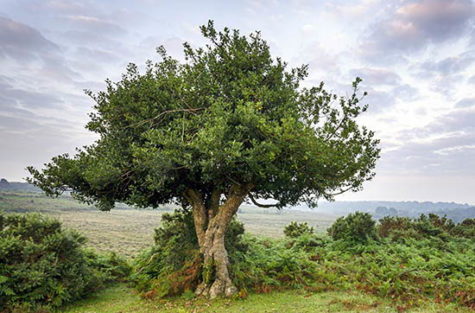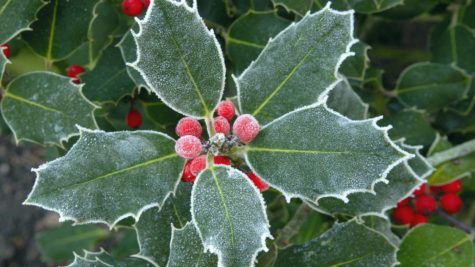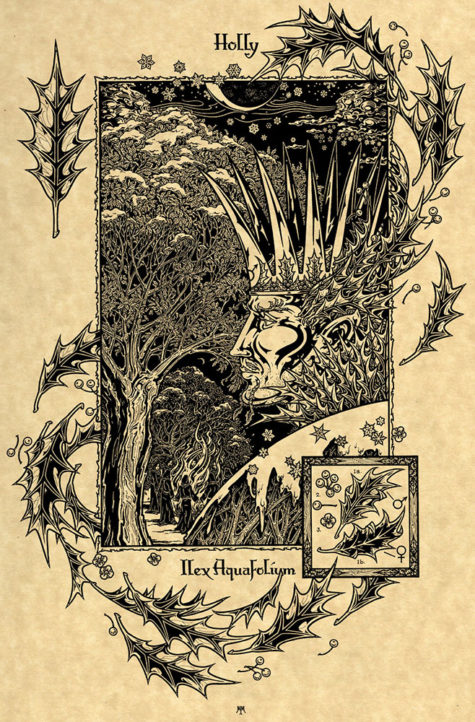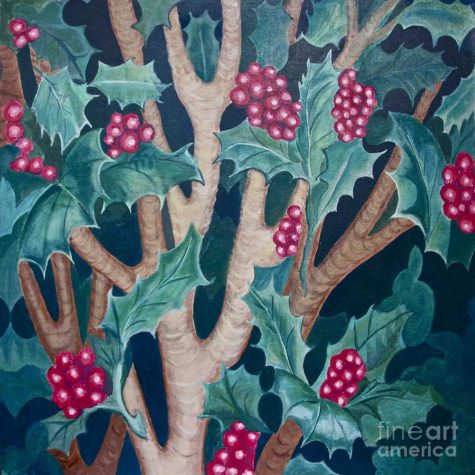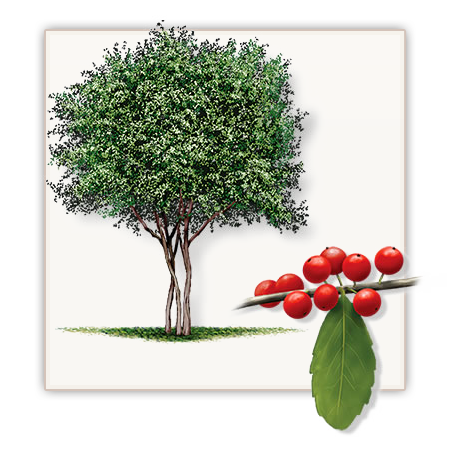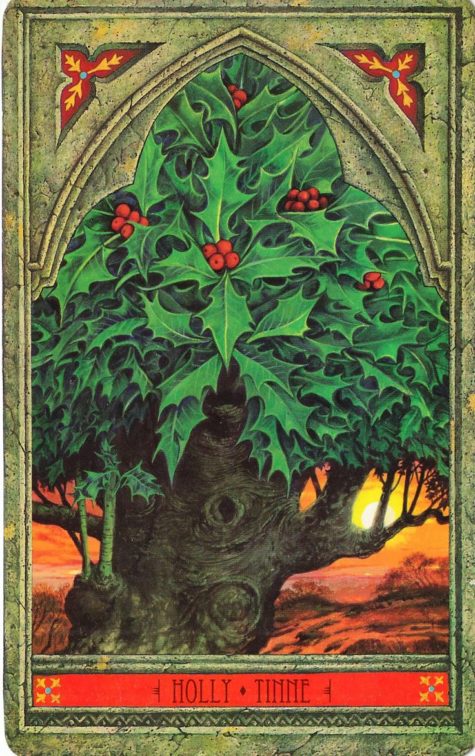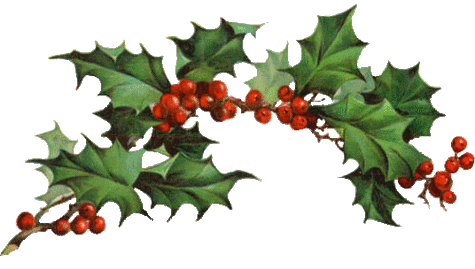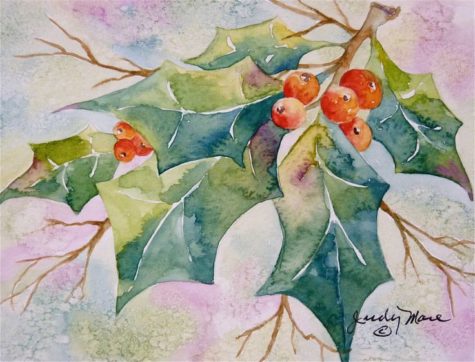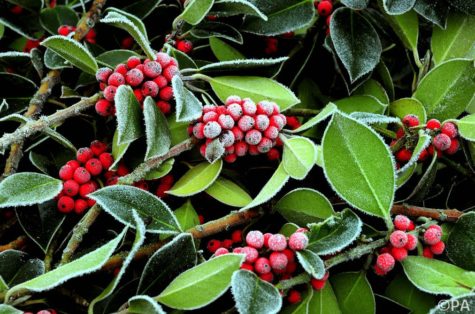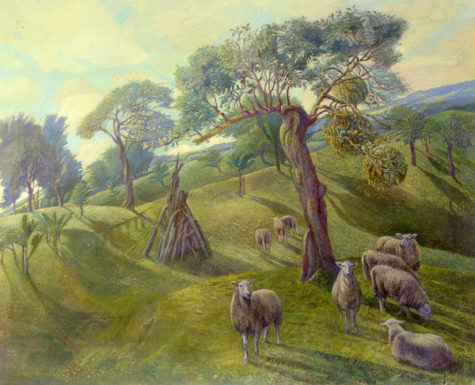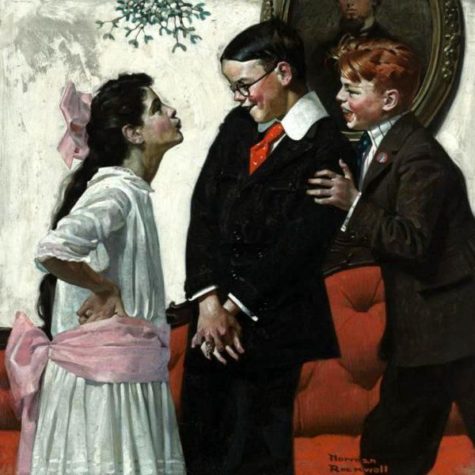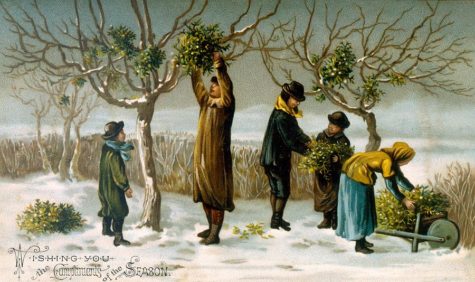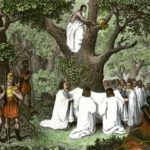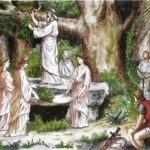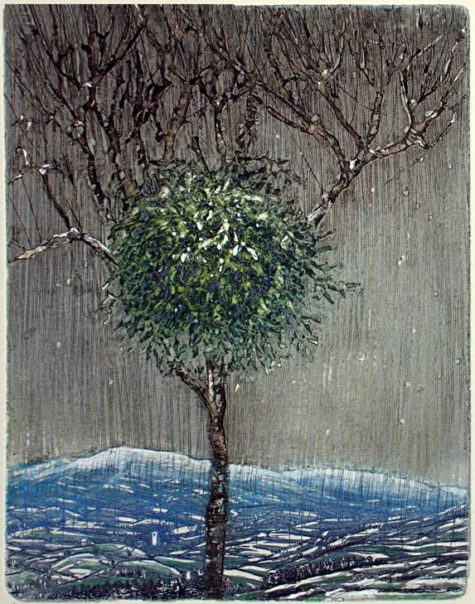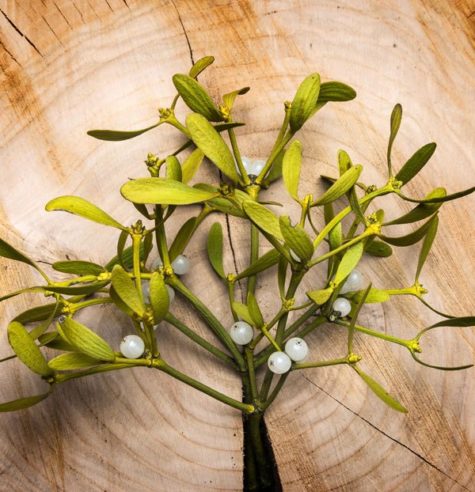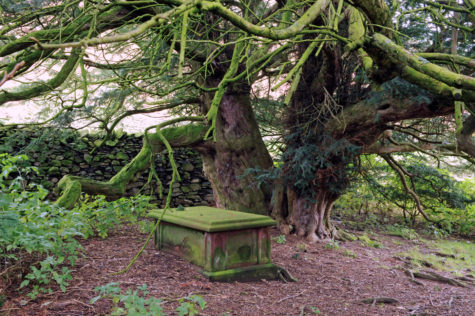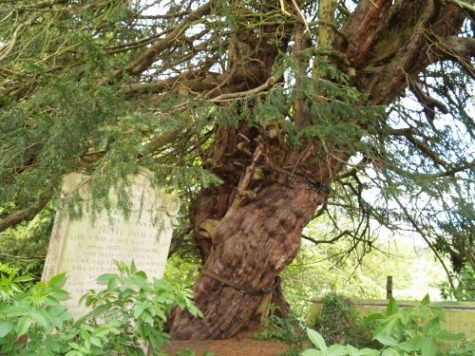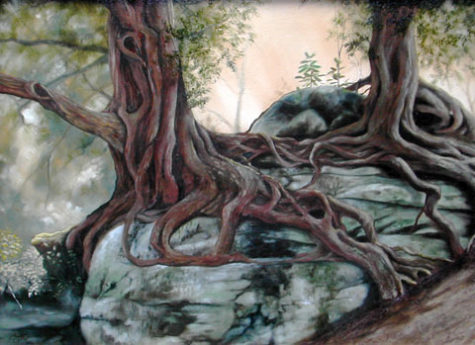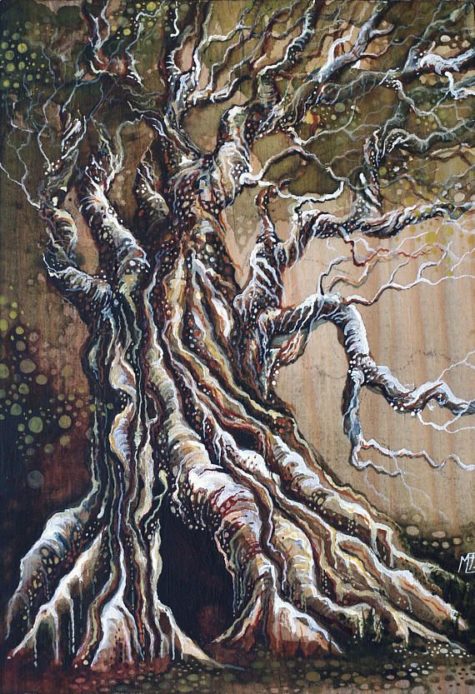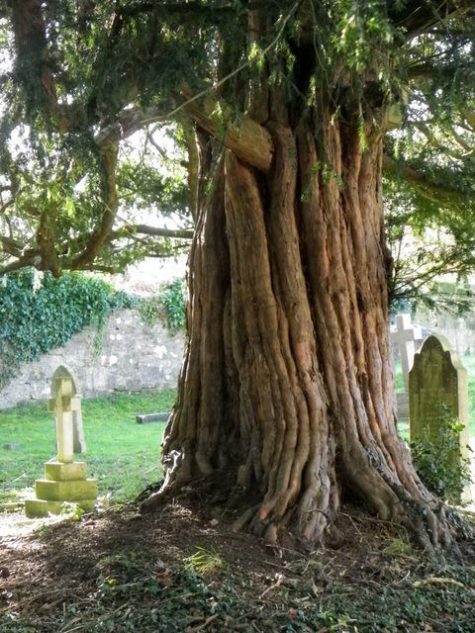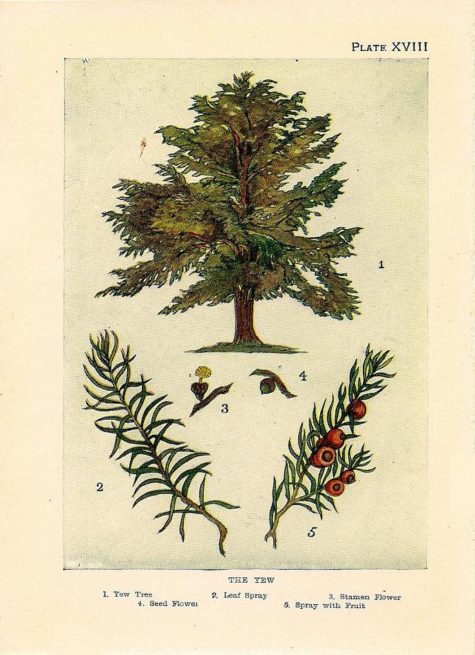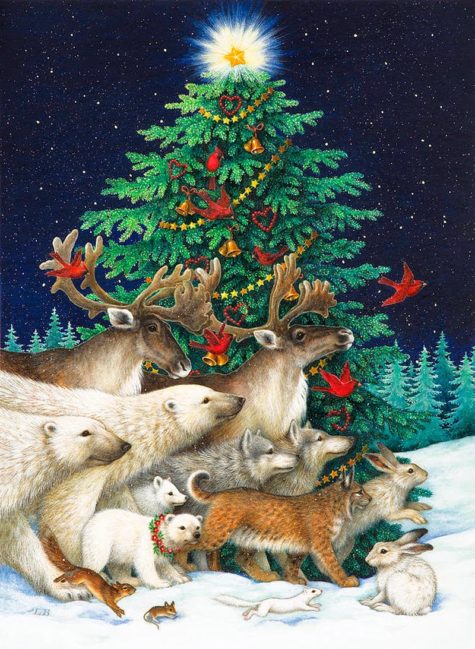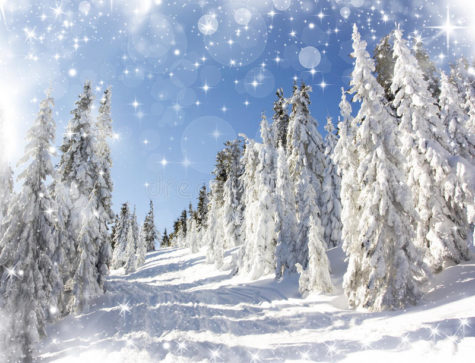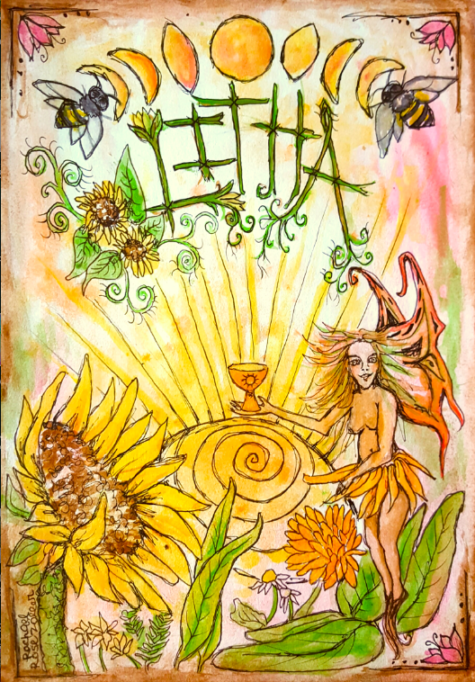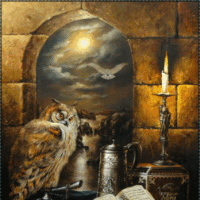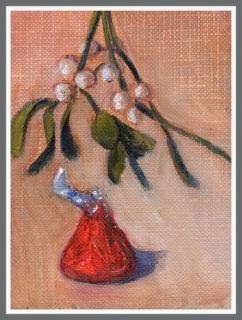Solstice
- Latin Name: Ilex aquifolium, Ilex opaca (American Holly)
- Celtic name: Tinne (pronounced: chihn’ uh)
- Known as: Tree of Sacrifice
- Folk or Common names: Holly, Aquifolius, Bat’s Wings, Christ’s Thorn, Holm Chaste, Hulm, Hulver Bush, Scarlet Oak, Kerm-Oak, Holy Tree
- Meanings: Holly actually means “holy”.
- Ruling Planets: Mars and Saturn
- Element: Fire
- Ruler: Sun
- Stone: Ruby, Bloodstone
- Birds: Cardinal, Starling
- Color: Red
- Deity: Lugh, Tannus, Thor, Danu
- Other: The Holly is an evergreen tree.
- Magickal Form: Wreaths, berries, leaves, wood
- NOTE: Holly berries are poisonous!
- Powers: Protection, Anti-Lightning, Luck, Dream Magick
Holly, being evergreen and having red berries, is a symbol of enduring life, and consequently it is considered a lucky plant almost everywhere. It is very unlucky to cut down a Holly tree.
The Holly Tree is one of the Seven Chieftain Trees of the Druids, its very name means “holy.” A Christian myth says that the blood of Christ formed the red berries of the holly. Holly is also associated with unicorns, since the unicorn is one of the Celtic symbols for this tree – the other symbol is the Flaming Spear.
Holly berries represent the blood of the Goddess. Use Holly berries with your favorite spell for female fertility and sexuality. Holly tames wild beasts and wards off storms and bad weather. Since it is a masculine herb, it brings good luck to men. The Romans considered Holly sacred and used it as a decoration during their Saturnalia celebrations.
Holly is sacred to the Winter Solstice, when it is used for decorating. Decorating one’s home with holly was believed to bring protection and good luck to the inhabitants in the coming year. Holly was used for decoration throughout homes with it being used for boughs over entrances to peoples’ homes or formed into holly wreaths that were hung on doors.
Sprigs of holly in the house at Christmastime will bring you good luck. But… be careful not to bring it indoors before Christmas Eve or your family will fall to squabbling. (Bet you wondered why that happened. grin…) Also be sure to burn it on 12th night (January 5th) or the good luck will turn sour.
Holly was the gift of good luck among the Romans celebrating their midwinter festivals. The northern tribes, who eventually brought about Rome’s downfall draped holly over doorways as shelter for friendly woodland spirits who could bring good luck to their houses.
The custom of bringing holly boughs into the home in the depths of winter has its origins in the original pre-Christian idea that its prickly leaves sheltered the fairy folk, who were delighted to come indoors at such a cold time of the year.
The wreaths are very popular around the Christmas / Yuletide season. Placing a ring of holly on doors originated in Ireland since holly was one of the main plants that was green and very beautiful with its red berries at this time of year and gave poor people a means of decorating their dwellings.
Unlike mistletoe, it appears in the Christmas Greenery of churches as well as ordinary houses. In some districts, when the rest of the decorations are burnt or thrown away at the end of the holiday, a holly-sprig is kept, to protect the house from lightning during the coming year.
- Planted near a house, holly repels negative spells sent against you.
- A bag of leaves and berries carried by a man increases his ability to attract women.
- Burn Holly leaves with Blessing Incense to protect the home and draw good luck.
- Place Holly above the door lintel for protection and to invite helpful spirits.
- Carry Holly berries in your pocket for protection.
The Holly tree (of which there are well over 150 species) can grow (albeit very slowly) to be as high as fifty feet and is native to most of Central and Southern Europe. Its white, star-shaped flowers bloom in the Spring and it bears shiny red berries in Autumn which last throughout the Winter season. The leaves of the Holly are shiny, dark green in color, elliptical in shape and have spiny points. In order to produce berries, both a male and a female tree are required. Only the female tree produces berries which, although lovely to look at, are poisonous.
Given its evergreen nature, the Holly represented immortality and was one of the Nine Sacred Woods used in Need-Fires (the others being Oak, Pine, Hazel, Juniper, Cedar, Poplar, Apple and Ash). In ancient Irish lore, it was also listed as one of the Noble Trees of the Grove (along with Birch, Alder, Willow, Oak, Hazel and Apple).
The Holly tree has a fine white wood which was once used in the making of inlays and for walking sticks as well as riding crops. Its leaves are a favorite food among deer and sheep during the Winter months. The wood of the Holly is hard, compact and beautifully white in color, being susceptible of a very high polish.
Magical History and Associations:
Each month of the Celtic Lunar calendar bears the name of a tree. Holly is the 8th Moon of the Celtic Year – (July 8 – Aug 4).
The Holly, a masculine herb, is associated with the element of fire, and is an herb of Saturn and Mars. The bird associated with this month is the starling, the color is green-gray, the gemstone is yellow caingorm, and the day of the week association is Tuesday. Holly is the first moon of the dark half of the year, and the Holly is sacred to both the Winter and Summer Solstices.
Summer Solstice is the time when in mythology, the Oak King is slain by his twin, or tanist, the Holly King, who rules until the Winter Solstice, when he in turn is slain by his tanist, the Oak King. Tanist is related to the tannin found in an Oak tree; Oak and Holly are two sides of the same coin, the end of one cycle and the beginning of the next.
Holly is one of the three timbers in the Chariot Wheel. It represents personal sacrifice in order to gain something of greater value.
The Holly is also sacred to the deities of Lugh, Habondia, Tina Etruscan and Tannus. There are special spirits that dwell within Holly trees: the Holly Man lives in the tree that bears prickly Holly, and the Holly Woman dwells within that which give forth smooth and variegated leaves.
Magickal usage:
The month of Holly is a good time to do magick designed to help bring about a successful harvest. The Holly has applications in magick done for protection, prophesy, healing, magick for animals, sex magick, invulnerability, watchfulness, good luck, death, rebirth, Holiness, consecration, material gain, physical revenge, beauty and travel.
Dreaming of Holly means you should be mindful of what is troubling you, and picking holly in your dreams means you will have a long life.
Holly also has the ability to enhance other forms of magic. As a symbol of firmness and masculine energy, Holly wood was used by the ancients in the construction of spear shafts, which were thought to then have magickal powers. Uses of Holly in protective magick includes hanging a sprig of Holly in the home all year to insure protection and good luck. Holly is also an excellent charm to wear for protection.
‘Holly Water’ can be made by soaking Holly overnight in spring water under a full moon. This water can then be sprinkled over infants to keep them happy and safe. Holly Water can also be used to sprinkle around the house for psychic cleansing and protection.
A “par excellence” protective herb, it protects against lightning, poison, and evil spirits. When thrown at wild animals it makes them lie down quietly and leave you alone. Holly leaves can be cast around outside to repel unwanted spirits or animals and a Holly bush can be planted close to houses to protect against lightning. Ensure that the Holly has a place in your garden because its presence wards off unfriendly spirits. Do not burn Holly branches unless they are well and truly dead, for this is unlucky.
Holly is considered the male counterpart to the female Ivy. Holly, intertwined with ivy, is traditionally made into crowns for the bride and groom at weddings/handfastings. Holly and Ivy also make excellent decorations for altars.
Holly is also a traditional decoration for Yuletide as in sung in the traditional Yuletide song:
“Deck the halls with boughs of Holly,
fa la la la la, la la la la.”
Even though Holly’s Yule festival greens are traditionally burned at Imbolg, a small sprig us kept for luck and to keep evil away throughout the year. Holly berries were used to predict winter weather. If there were a profusion of berries, that meant it would be a hard winter, because the Goddess was providing extra berries for the birds.
When harvesting the leaves from the Holly, remember to ask the tree if it will allow you to take the parts and be sure to leave the tree an offering of thanks when you are done. Holly favors red and yellow stones as gifts.
A north country charm to induce dreams of a future mate required the seeker to go out in silence at midnight on a Friday, and gather nine she-holly leaves (the smooth variegated variety). These had to be tied with nine knots in a three-cornered handkerchief, and laid under the pillow before going to bed. The future husband or wife would appear in a dream, but only if complete silence had been preserved from the moment of setting out to gather the leaves until dawn the next day.
The Deeper Meaning of Holly
It is during June that the light of the sun reaches its culmination, and then begins its descent into earth. The Holly speaks to the fierce capacity of the human soul to take the descent into the underworld, bringing inner light into darkness. Thus we can understand the signature of the tree, with its ability to germinate without sunlight, favoring dark, moist conditions that are more strongly related to the downward earth pole. Its stiff, pointed leaves are not unlike thorns or “spears.”
The Holly yields a hard, white close-grained wood that imparts a quality of solidity and impermeability, as it stands in the depths of winter, impervious to cold and darkness with its somber evergreen color.
The Druid initiates developed a sacred alphabet, called the Ogham, based upon the archetypal qualities of trees. The Holly, known in Gaelic as Tinne ruled the eighth moon of the year, or the month of June. The glyph for Holly is that of a spear, meaning literally, “I am a battle-waging spear.”
Of all the trees in the Ogham, the Holly and the Oak are most primordial—they are viewed as two “kings” who exchange leadership on a yearly basis by engaging in symbolic battle. The Gaelic name for Holly—Tinne—is related to the word, tanist, meaning “dark twin.” The Oak King rules from the time the light begins its ascent in December until the summer solstice in June. Holly is the “dark twin” who reigns during the waning light of the year, until winter solstice.
The Holly’s prominence at Christmas is actually meant to represent a culminating experience within the soul life. It is an awakening of the love forces of the heart achieved through a descent into the interior of the self and the earth that comes to fruition during this festival. This understanding is depicted in Rudolf Steiner’s Calendar of the Soul.
Steiner is a modern initiate who incorporated the mystery streams of earlier cultures, including Druidic wisdom. His calendar is a series of 52 runic verses for each week of the year. Beginning at summer solstice, the soul gradually finds its way into an interior reality, moving out of the great cosmic heights. The sense of self coalesces like a seed, with light working into the inmost being, as a purifying and strengthening force. Then, at winter solstice, this light is quickened and shines forth from the heart chakra:
To carry spirit light into
World Winter-night
My heart is ardently impelled
That shining seeds of soul
Take root in world ground
And the Holy Word resounds
Through the darkness of the senses
Transfiguring all life.
In subsequent winter verses Steiner describes this activity of the soul as a “heart-high gladness”. It is the inner light of Self-containment gained by living in “spirit depths”—at one with the “world ground.” The soul is so solidly secure and anchored within itself that nothing can assail one’s sense of deep peace. When this consciousness is mastered, the journey inward of the Self is complete. The heart awakens with a streaming of love, gradually seeking its way outward into the sense world again to meet the expansive forces of the light in spring and summer.
We could say that the Holly flower which blooms in outer nature in late spring/summer, blossoms again in the human heart during winter as a force of love. Its nature is a sun force that lives, not in the heights but in the depths of the earth.
Perhaps the most profound archetypal picture of Holly is evoked through its symbolism as the Crown of Thorns. As the traditional Christmas carol proclaims, Of all the trees that are in the wood, the holly bears the crown.
Druid priests wore Holly in their hair while collecting the sacred mistletoe medicine in the winter, Holly was also worn as a crown to represent the Holly King in seasonal festivals. The Holly Crown was a sign of deepest respect and recognition that such an initiate had mastered the forces of nature in harmony with the human soul.
The Holly tree came to be known as Christ-Thorn in middle Europe, for it was recognized that this plant spoke to the archetypal reality of the Crown of Thorns as a soul initiation. The Crown of Thorns is also a kind of “beheading.” The false self must be pressed down with a Crown of Thorns until it finds a deeper truth in the human heart. The “battle waging spear” is thrust not outside, but within.
Holly teaches us that we cannot find love outside ourselves, if it is not anchored from within the human heart. Holly creates what is divine from within what is human. Holly helps the human heart know its own wholeness; its own holiness.
Herbal usage:
The powdered leaves were brewed into a healing tea for measles, fevers, bladder problems and bronchitis, and the ashes from burning the leaves in a drink soothed whooping cough.
Hot compresses made from the leaves and bark helped ease the pain of broken bones and dislocations. The juice of the fresh leaf is helpful in jaundice treatment. Holly can be used homeopathically as a substitute for quinine.
Note: Holly berries are poisonous!
Holly Folklore and Superstition
Male, or prickly, holly is lucky to men, as the smooth variegated type, known as the she-holly, is to women. If the First Foot on his rounds brings evergreens with him, it is usually holly that he chooses, but in this case it must be the male kind, for the other variety, being female, would be very ill-omened.
Holly branches must never be burned when green. To do this is extremely unlucky, and may cause a death in the family. It is also unlucky in some places to stamp on a holly berry, or to bring the plant indoors when it is flowering.
A well-known country remedy for chilblains is to thrash them with a holly bush “to let the chilled blood out.” This probably does some good by restoring the arrested circulation, but the choice of holly rather than anything else as a thrashing agent is made for magickal reasons.
Sources:
- Holly The Heart Healer
- Encyclopedia of Magickal Ingredients
- dutchie.org
- Encyclopedia of Superstitions
According to the Celtic mythology of trees, Mistletoe is the tree of the day after the Winter Solstice (Aprox. December 23). In Druidic lore Mistletoe is an herb of the Winter Solstice and is the special plant for the day after Yule.
- Latin name: Viscum Album
- Celtic name: It is said that Mistletoe is too sacred to have a written word.
- Folk or Common names: Donnerbesen, Birdlime, All Heal, Golden Bough, Devil’s Fuge, Thunderbesom
- Parts Used: Leaves, berries, twigs
- Basic Powers: Protection, Love
Mistletoe is a plant of the sun and also of the planet of Jupiter. It is associated with the element of the air. The colors of Mistletoe are green, gold and white, and its herb is hyssop. The gemstones associated with Mistletoe are Black Quartz, Amber, Pearl and green Obsidian. Mistletoe has the immortal creature the Gryphon-Eagle associated with it and also the plain eagle is its bird association. There are many deities associated with Mistletoe: Loki, Blader, Hercules, Shu, Osirus, and Aeneas are a few of those deities.
Magickal usage:
Romans, Celtics, and Germans believed that mistletoe is the key to the supernatural. Mistletoe will aid and strengthen all magickal works but is best called upon for healing, protection, and beautiful dreams – dreams which will unlock the secrets of immortality. Mistletoe is a good wood to use for making wands, other ritual tools and magickal rings.
The Berries are used in love incenses, plus a few berries can be added to the ritual cup at a handfasting. Boughs of Mistletoe can be hung for all purpose protection around the house. Sprigs of Mistletoe can be carried as an herb of protection – plus amulets and jewelry can be made out of Mistletoe wood as protective talismans.
Hung over the cradle, Mistletoe will protect the child from being stolen by the fey and Mistletoe that is carried will protect the bearer from werewolves. Mistletoe stood for sex and fertility – hence our tradition of kissing under the mistletoe. It is traditionally hung in the home at Yule, and those who walk under it exchange a kiss of peace.
Pick on Midsummer’s Eve, or when the moon is six days old (six days after the New Moon). Wear as a protective amulet, or to help conceive. The wood is often carved into rings and other magickal objects. A good anti-lightning charm. The herb hung anywhere is an excellent all-purpose protective device. Extinguishes fire. Wear as an amulet to preserve against wounds.
Kissing Under the Mistletoe:
Kissing under the mistletoe seems to be a purely English custom, of which no trace has been found in other countries unless Englishmen have settled there at some time. Strange as it may seem to us now, the English were once much given to kissing. Foreign visitors in the 16th and 17th centuries frequently remarked with surprise on the way in which men and women exchanged kisses without self-consciousness, even slight acquaintances and newly-introduced strangers being thus pleasantly greeted.
The last shadow of this old freedom is now cast by the mistletoe bough at Christmas. If a girl stands under it, she cannot refuse to be kissed by anyone who claims the privilege. At one time, the young men had the right to pluck a berry from the bough for every kiss they took.
It was also thought that if a girl was kissed seven times in one day under the mistletoe, she would be married within a year. A girl who stood under the mistletoe but did not receive a kiss was doomed to remain without a husband for at least one year. A girl who gets married without ever having been kissed under the mistletoe will never have children.
Kissing under the mistletoe is not only for lovers. You should kiss anyone and everyone possible while the mistletoe is hanging. This brings good luck to everyone in the house for a whole year.
Magical History:
Mistletoe, the Golden Bough of classical legend, was a sacred and wonder working plant alike for the Celtic Druids, by whom it was ceremonially cut at the Winter and Summer Solstice festivals. Mistletoe is one of the Druid’s most sacred trees – as Ovid said, “Ad viscum Druidae cantare solebant.” (The Druids are wont to sing to the Mistletoe.).
The Druids gathered their Mistletoe at Midsummer or at the 6th day of the moon. The Druid priests or priestesses would wear white robes while gathering the plant and would use a golden knife to cut the plant from the tree.
The mistletoe was caught in their robes to prevent any from falling to the ground, where it would lose its magickal qualities, and so extreme care was taken not to let the plant touch the ground. Two oxen were often sacrificed for the harvest. The Druids considered that the Mistletoe that grew on Oak trees was the most potent and sacred.
For the Norsemen, it was the holy and terrible plant which slew Baldur the Beautiful when all things in Heaven and Earth had sworn not to harm him. But the mistletoe was forgotten because, rooting on trees and not in the ground, it was not in Heaven or Earth, but only between them. Consequently Loki, the trickster, was able to use it to kill the Dun God when all other things had failed him.
It was also the plant of peace in ancient Scandinavia. A bunch hung outside a house denoted a safe welcome within, and if enemies happened to meet under a tree that bore it, they had to lay down their arms and fight no more on that day.
It is said that if a branch or sprig of the mistletoe was cut with a new dirk on Halloween, after the cutter had walked three times round the oak sunwise, it was sure guard in the day of battle, and a protection at all times against glamour and witchery. A similar sprig laid in the cradle protected the child from being stolen by the fairies and replaced by a changeling.
Being a thunder-plant, its presence in a house protected it from thunder and lightning, as well as from witches and evil spirits. In Britain, it was anciently called All Heal, because it cured many diseases, composed quarrels, and was an antidote to poison. It brought good luck and fertility. For all these reasons it was, and remains, an essential part of Christmas decorations in almost every house, though not in churches.
Its strong pagan associations probably caused it to be banned from churches at Christmas or any other season. This prohibition still prevails in most parishes, and if a sprig or branch is accidentally included in the general greenery, it is usually removed as soon as the clergyman sees it. In one Oxford parish several years ago, permission was given to hang a bunch in the porch, but not inside the church itself.
An exception to this rule in the Middle Ages was at York Minster, where a branch was ceremonially laid on the altar on Christmas Eve and left there throughout the Twelve Days of Christmas. A general pardon and liberty throughout the city was proclaimed for so long as it remained there.
In Worcestershire, where it grows very freely, it is said to be unlucky to cut mistletoe at any time but Christmas. Until very recently (and perhaps still in some households), it was usual to keep the Christmas bunch throughout the year for good luck, and then to replace it by a new one on Christmas Eve.
In some districts, sprigs from such a bunch were given to the cow that calved first after New Year’s Day, to ensure the prosperity of the herd in the following twelve months. In Herefordshire formerly, it was unlucky to bring mistletoe into the house before New Year’s morning. It was not included in the Christmas decorations, but was brought in at the time of the Burning the Bush.
To cut down a mistletoe-bearing tree was once considered to be very unlucky. Many stories are told of misfortunes which fell upon those who did so.
A curious tradition relating to the Hays of Errol, in Perthshire, is connected with this idea. The continued existence and prosperity of that family was bound up with an ancient mistletoe-bearing oak growing near the Falcon Stone. So long as the tree stood and the mistletoe grew on it, they would flourish, but, as we read in the verses traditionally ascribed to Thomas the Rhymer,
… when the root of the aik decays,
And the mistletoe dwines on its withered breast,
The grass sall grow on Errol’s hearthstone,
And the corbie roup in the falcon’s nest.
Oak and mistletoe together have vanished now, and the estate no longer belongs to the Hays. Exactly when the tree was cut down is not now remembered, but local tradition says that it was before the lands were sold, and that it was because of that destruction they were lost to the family.
Herbal usage:
CAUTION: Mistletoe berries are extremely poisonous and have been known to cause miscarriage.
Mistletoe tea was widely believed to cure the falling sickness or epilepsy, and is still recommended by herbalists for that purpose. The plant was also used in folk-medicine for a variety of other ills, including St Vitus’ Dance, heart troubles and nerve complaints, sores, the bites of venomous creatures, and toothache.
Mistletoe can be used as a stimulant to soothe muscles and to produce a rise in blood pressure. It increases the contraction of the uterus and intestine. Mistletoe has been recommended as an oxytocic in postpartum hemorrhage and menorrhagia. It is also used as a circulatory and uterine stimulant. This plant can induce menstruation. It has shown effective in treating tumors in some animals. It is recommended that due to the toxicity of this plant that ingestion of this herb be avoided.
Sources:
- Magickal Herbalism
- Encyclopedia of Superstitions
- Dutchie.org
- Ruler: Saturn
- Type: Tree
- Magickal Form: Branch and Leaves
- Meaning: Complete change in life-direction or attitude
This is a dark tree, ruled by the Crone. It is used in spells to raise the dead. Yew is also used in ritual to help make the transition into menopause. According to Celtic tree mythology, the Yew is the tree of the day before the Winter Solstice (Approx. December 21).
- Latin name: Taxus baccata.
- Celtic name: Idho (pronounced: Ih’ huh).
- Folk or Common names: English Yew.
The evergreen yew, which lives to an immense age, extending over many generations of men, is a natural symbol of life everlasting, and seems to have been so regarded from time immemorial, alike by pagans and by Christians.
Because of its great longevity, the yew is a symbol of everlasting life. It grows in an unusual way, too, its new stems growing down the outside of the tree, giving the yew an association with rebirth and regeneration, as the new is born from the old. Adding to this symbolism is its habit of putting in a growth spurt when it is around 500 years old.
So sacred was the yew as a symbol that – to a pre-Christian society – wherever it grew was considered to be sacred ground. It was considered both immoral and illegal to chop down the tree. It is likely that the yew is often seen in churchyards because the church itself would have been built on this sacred ground in the presence of the tree, in an effort to align the incoming Christian belief system with pagan traditions.
The association of the tree with death therefore started to overlay its former meaning. Because the berries of the yew are poisonous, they can effectively carry people into the spirit world.
At English country funerals formerly, the mourners often carried branches of yew, which they laid with the dead man in the grave. Small sprigs were also inserted in the folds of his shroud in some districts, before the coffin was nailed down. These typified, not the end of life, but its continuance in the resurrection to come.
Similarly, yew-boughs are usually included today in church decorations at Easter, because they symbolize the triumph of life over death and so are fitting emblems of the Resurrection.
The hollow center of the yew tree is a symbol not only of the power that lies in empty space, but underlines the significance of this tree as belonging, in part, to a spiritual dimension. Recently, the yew as a symbol of life has been shown in a practical and unexpected way. One of the constituent chemicals of the tree, taxol, has been found to be efficacious in curing breast cancer.
Old Ideas About The Yew
In Elizabethan times it was considered an unlucky plant. The Elizabethans tossed sprigs of yew into graves to ensure that the spirits of the dead did not come back to haunt the living.
To cut down a yew tree growing in a churchyard, or to burn or damage its branches, is very unlucky. It is also said to be unlucky to bring yew branches into the house, and most people are careful to omit them from the evergreens used for Christmas decorations.
In the Scottish Highlands, in the days of clan warfare, there was a curious tradition which said that if a chief too a piece of churchyard yew in his left hand, and then denounced or threatened his enemy, the latter, though present, would hear nothing, though all around could hear quite clearly what was said. This presumably, enabled the speaker to claim afterwards that he had given due warning of his intentions, while at the same time retaining the advantages of a surprise attack on a totally unprepared victim.
Although at one time it was considered dangerous to carry a sprig or branch of yew into the home, in Herefordshire, a girl who wished to dream of her future husband went to a churchyard that she had never visited before and plucked a sprig, which she laid under her pillow at night. This would enable her to see her future partner in her dreams.
In the north-midland counties of England, lost goods could be found if the seeker took a branch of yew and held it out before him as he walked. He would be led straight to the place where the lost things were, and when he reached it, the branch would turn in his hand.
The yew is also renowned for protecting homes and other buildings from witches and evil spirits. It is believed that you are likely to die within twelve months if you trim or cut down a yew tree.
Magickal Associations of Yew
Bulls are associated with this tree, as are female goats. The bird associated with Yew is the eaglet, since the eaglet’s appetite is insatiable, and the bones of its nest are white like the snow on its cliff-ledge. The Yews colors are white and silver and it is associated with the element of water. The Yew is associated with the planet Saturn and with the metal lead. In Old England the Yew was known as “The Witches Tree” since it is associated with sorcery and magick.
Magickal usage:
The time of Yew is known as a time of death, and so on the day before Yule it said that is not a good idea to do actual spell work, instead it is suggested to do rituals of the season concerned with reincarnation. Because the Yew grows to such an old age, it has become a symbol of stability in Celtic areas of the world and so is often used as the central “World Tree” in ritual spaces.
As one of the three magickal trees (along the Alder and the Black Poplar) associated with death and funerals, the Yew has often been planted in graveyards. Yew sends up new trees from its roots, so is a powerful symbol of death and reincarnation.
Yew wood is appropriate for magickal tools such as wands and staves. In ancient times Yew sticks were carved with the Ogham characters as tools of divination. The Futhark features a 13th Rune, which is considered one of the most powerful Runes and represents a stave cut from a yew tree. This Rune is regarded as the stave of life and death. Yew can be dried and burned as an incense to contact spirits of the dead – and even to raise the dead.
If you are going to plant a Yew tree, it is best planted in the South-West corner of the property.
Magical History:
The name “Yew” is a corruption of the Anglo-Saxon word ‘eow’. The word ‘Taxus’ is from the Greek word ‘Taxon’, meaning ‘bow’. The 5000 year old “Ice Man”, discovered in the Alps, had a bow and axe handle made of Yew.
The Yew is known as the ‘Tree of Death’ through out Europe and is associated with the season of winter. It is sacred to many Dark Goddesses: Banbha, Amalthea (mother of the horned Dionysus), Morrighan, The Erinyes, Cailleach Beara, Berchta, and Hekate.
Shakespeare recognized the relationship of Yew and Heckate and referred to the contents of her cauldron as “slips of yew, silver’d in the moon’s eclipse…” (Macbeth) – and elsewhere Shakespeare makes ‘hebenon, the double-fatal yew’ the poison which Hamlet’s uncle pours into the king’s ear. Heckate’s sacred tree of death is said to root in the mouths of the dead and release their souls, and also absorbs the odors of death itself.
Yew wood is tough and durable and was used for making shields and spears, and also – using both heartwood and sapwood to gain extra strength – the famous English longbow that helped the English win the Battle of Agincourt in 1415, at which they were completely outnumbered. Hence the yew is also a symbol of the warrior.
Herbal usage:
This plant is poisonous and should never be ingested unless you are 100% sure that you know what you are doing. The needles and branch tips have been used to treat lung diseases and bladder problems. recently a new cancer drug, Taxol, has been derived from its bark and berries.
Sources:
- Encyclopedia of Magickal Ingredients
- Encyclopedia of Superstitions
- Element Encyclopedia of Secret Signs and Symbols
- Dutchie.org
This beautiful second stop on the new Wheel of the Year represents the rebirth of the Sun! During Yule, we celebrate the ability to begin cultivating strength.
As the Holly King dies and The Goddess gives birth to the Oak King, we realize that we must thank and release the internal struggles that we worked through during the dark half of the year. Then, we welcome in the strength to use the lessons from our prior hardships. We celebrate the light that always comes after the dark, the peace that comes after the struggle.
- The Gods Of Yule: Apollo, Attis, Balder, Bacchus, Dionysus. The Green Man, Helios, Lugh, The Oak King, Odin, Ra, Sol
- The Goddesses of Yule: Aphrodite, Brigid, Demeter, Fortuna, Gaia, Hel, Holle, Ishtar, Isis
Yule Spell Work: Spell craft performed for Yule should be for peace, harmony, hope, strength, love, and increased happiness. Unconditional love, World healing, and World peace.
Symbolism of Yule:
- Hope after darkness,
- Lights to bring back the Sun,
- Rebirth of the Sun
At the Winter Solstice, the two god themes of the year’s cycle coincide – even more dramatically than they do at the Summer Solstice. Yule (from the Norse iul, meaning wheel) marks the death and the rebirth of the Sun God; it also marks the vanquishing of the Holly King, the god of the Waning Year, by the Oak King, the God of the Waxing Year.
The Goddess, who was Death-in-Life at Midsummer, now shows her Life-in-Death aspect; for although at this season she is the leprous white lady, Queen of the cold darkness, yet this is her moment for giving birth to the Child of Promise, the Son-Lover who will re-fertilize her and bring back light and warmth to her Kingdom.
- Symbols: Evergreens, Holly, Mistletoe, Poinsettias, Lights, Yule Log, Wreaths, Bells, Gifts, Stars, Sun, Snow, Ornaments, Garland, Santa Claus, Reindeer
Activities Of Yule:
Modern Christmas celebrations are full of pagan symbology. Santa Claus is the Holly King, the sleigh is the solar chariot, the eight reindeer are the eight Sabbats, their horns represent the Horned God, the North Pole symbolizes the Land of Shadows and the dying solar year, and the gifts are meant both to welcome the Oak King as the sun reborn and as a reminder of the gift of the Holly King, who must depart for the Oak King to rule.
- For prosperity: burn ash wood.
Activities include: caroling, wassailing , burning the Yule log, decorating the Yule tree, exchanging of gifts, feeding animals, birds with grains and seeds, become a part of nature, acts of kindness, wreath on the door, mistletoe indoors, kissing under the mistletoe, food and clothing donations, sunflower seeds outside for birds, ring the bell to greet the Solstice Morn, and perform magick for a peaceful planet.
- For Yule blessings: Gather up Yule greens after 12th night and save. At Imbolg, burn the greens to banish winter and usher in spring.
Foods of Yule:
Cookies and caraway cakes soaked in cider, nuts, eggnog, ginger tea, warm and warming drinks, spiced cider, wassail, or lamb’s wool (ale, sugar, nutmeg, roasted apples), figgy pudding, mincemeat pies, and fruit cakes, apple cider, spiced cinnamon cakes and cookies, dried fruits, eggnog, gingerbread, mulled wine, roasted meats, spiced meats, roasted apples.
Trees for Yule:
- Oak : Endurance, Strength, Triumph, Protection.
- Yew : Last Day of Solar Year; Death
- Silver Fir: Winter Solstice Day; Birth.
- Birch: Month following Winter Solstice; Beginnings.
The Animals of Yule:
Bears. Deer, Owls, Phoenix, Reindeer, Snow Geese, Squirrels. Stags, Cardinals, Wrens, and Ravens.
Yule Colors:
Gold, Green, Red, White, Silver, Yellow, Orange
Herbs for Yule:
- Bay Laurel, Blessed Thistle, Chamomile, Cinnamon, Evergreen Trees, Holly, Ivy, Juniper, Mistletoe, Pine, Poinsettias, Rosemary, Sage, Wintergreen, Holly, Fir, Birch,
Sun plants like mistletoe, balsam, and fir, and also any dried herbs from Summer, are predominant this time of year because they contain light and warmth.
On Yule, when witches decorate their houses, they do so from the doorway inward, this inviting the light inside. We adorn doorways and mantles with evergreen boughs, bunches of dried summer herbs and Witches cords in reds, blacks, greens, and golds. Our ancient ancestors brought an evergreen tree inside to mystically ensure there would be light all year round. The evergreen retains sunlight, staying green all year, and reminds us that life is forever present and renewable.
Other Yule herbs, plants, flowers and seeds:
- Pine cones, Pine needles, Oak leaves, Yule log ashes, Hazel bark, Apple leaf, Dried apples
Incense and Oils for Yule:
Cedar, Cinnamon, Clove, Frankincense, Juniper, Myrrh, Orange, Pine, Ginger, Wintergreen
Gemstones for Yule:
Rubies, Bloodstones, Garnets, Emeralds, Diamonds, Clear Quartz
In summary:
Being the time of rebirth, this is a great time to remove anything that holds us back and to sow the seeds for the upcoming year. Success spells are best cast this evening. Many people also perform blessings, not only for themselves and their families, but for others as well. Cleansing your home and altar and banishing negativity can also be done this night. Whatever you do, make sure your heart is filled with peace, love, and joy and work magic to bring merriment to others.
According to Celtic tree mythology, the Silver Fir is the tree of the day of the Winter Solstice. The Winter Solstice. This usually takes place on December 20th or 21st, although it does sometimes occur on the 22nd or 23rd (check your calendar as it changes from year to year).
- Latin name: Abies alba.
- Celtic name: Ailim (pronounced: Ahl’ em).
- Folk or Common names: Common Silver Fir, Balm of Gilead Fir, Balsam Fir, American Silver Fir.
- Parts Used: Needles, wood, sap
Magical History and Associations:
The Silver Fir is associated with the moon and with the planet of Jupiter. Its colors are piebald and light or pale blue. Its birds are the eagle and the Lapwing, and its animal association is the red cow. Its stones are Tourmaline and Amber – and it is a feminine herb. This tree belongs to the triple aspect Goddess in Celtic lore, offering learning, choice and progress. The tree is sacred to many Goddesses: Artemis (the Greek Goddess of Childbirth), Diana and Druantia among them. It is also sacred to the Gods Osiris and Attis, both who were imprisoned in Fir/Pine trees.
Magickal usage:
Burn to cleanse a room of negative vibes. This is a wonderful incense for healing and strengthening the physical, emotional, and spiritual body. The scent opens the heart and increases endurance.
The Silver Fir is used for magick involving power, insight, progression, protection, change, feminine rebirth, and birth. The Silver Fir and the Yew are sisters standing next to each other in the circle of the year and their foliage is almost identical. However the Yew is known as the tree of death and the Silver Fir is the tree of birth or rebirth. The Silver Fir was a sacred tree to the Druids who felt that it stood for hope. The Silver Fir wood is used for shape-shifting and magic involving change, since it offers a clear perception of the present and the future.
The wood chips are sometimes used as incense and the wood can be used in the construction of magickal musical instruments. Burning the needles of the Silver Fir or sweeping around the bed with a branch that has been blessed will protect a new born baby and its mother. In the Orkney area of Scotland, the new mother and baby are ‘sained’ by whirling a fir-candle three times around her bed.
For a ‘Weather Witch’ the cones of the Silver Fir warn of wet weather and foretells when a dry season approaches. Charms made of Fir can be given as good luck tokens to departing friends. In its appearance (and in its current, and undoubtedly ancient, use) the Silver Fir is the quintessential Yule tree. Its branches can be used as decorations at Yule time either as wreaths or as garland, where it will provide protection for the household and its occupants.
Recommended Reading:
- Year of Moons, Season of Trees
- Tree Medicine Tree Magic
- A Druid’s Herbal
- Celtic Astrology
- Glamoury: Magic of the Celtic Green World
- The Book of Druidry
Source: Dutchi.org
Heather is sacred to the Summer Solstice, the date of which varies slightly from year to year, and falling between June 20 and June 22.
- Latin name: Calluna vulgaris
- Celtic name: Ura (pronounced: Oor’ uh)
- Folk or Common names: Common Heather, Ling, Scottish Heather
- Ruler: Hestia or Vesta, Isis,
- Planet: Venus
- Element: Water
- Parts Used: herb, flowering shoots, dried or fresh flowers, or oil.
- Basic powers: For magick involving maturity, consummation, general luck, love, ritual power, conjuring ghosts, healing, protection, rain-making and water magick.
When worn or carried, this virginal flower wards off unwanted sexual advances. It essentially tones down the passions. Carry as a guard against rape. Take a bath in heather flowers, preferably during the moon’s waning phase, to help break sex addictions. Wear heather oil to bring a relationship back to a friendship.
Burn with fern to attract rain.
Add the flowers to a floor wash to bless the home. Sprinkle some around the workplace to calm down a tyrannical boss.
Heather is considered a lucky plant, and sometimes gypsies sell sprigs of it for luck. White heather is the luckiest variety, but in Scotland people have doubts about this. This is because a sprig of it was given to Bonnie Prince Charlie in 1745, and it did him no good at all.
Magical History and Associations:
Heather is associated with the sun, and with the planet of Venus. Its color is resin colored and its element is water. Heather’s bird is the lark, and its animal association is the honey bee. In ancient times the Danes brewed a powerful beer made from honey and Heather. And for centuries the heather flowers have also been a special beverage to the bee, who in return creates delightful Heather honey! Its stones are amethyst, peridot, and amertine – and it is a feminine herb. The herb is sacred to many Goddesses: Isis, Venus-Erycina, Uroica, Garbh Ogh, Cybele, Osiris, Venus, Guinevere, and Butes among them.
White Heather was considered unlucky by Scottish loyalists because of its connection with the banishment of Bonny Prince Charles. Heather is the home to a type of Fey called Heather Pixies. Like other Pixies, the Heather Pixies have clear or golden auras and delicate, translucent wings. But these faeries are attracted specifically to the moors and to the Heather which covers them. They are not averse to human contact, but they don’t seek them out. They have a pranksterish nature.
Magickal usage:
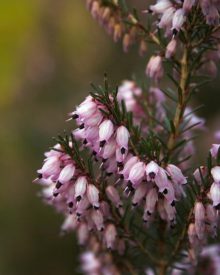 Heather is used for magick involving maturity, consummation, general luck, love, ritual power, conjuring ghosts, healing, protection, rain-making and water magick. Charms made with Heather can be worn or carried as protection against danger, rape and other violent crimes.
Heather is used for magick involving maturity, consummation, general luck, love, ritual power, conjuring ghosts, healing, protection, rain-making and water magick. Charms made with Heather can be worn or carried as protection against danger, rape and other violent crimes.
This flower represents good fortune and Heather can also be carried as a lucky charm. It was believed that wearing the blossom associated with your month of birth would bring exceptionally good luck – therefore people born in the month of Heather (August) should carry White Heather, for even better luck throughout the year.
Legend has it that a gift of white Heather brings luck to both the giver and the receiver, whereas red Heather is said to have been colored by heathens killed in battle by Christians, so is less lucky.
Heather is associated with secrets from the Otherworld. A sprig of white Heather placed in a special place of silence and meditation has the power to conjure ghosts, haints or spirits.
After picking a piece of white Heather at midnight, place it in a glass of river water in the darkest corner of your home. Sit and think of a departed loved one and it is said that the loved ones shadow will visit you.
Heather is said to ignite faery passions and open portals between their world and our own. Heather represents solitude because it thrives in wide open spaces, and Faeries who enjoy living in such undisturbed places are said to feast on the tender stalks of Heather. The Fae of this flower are drawn to humans who are shy.
Heather is useful for Solitary healing work (going within). Heather, if used along with Mistletoe, creates powerful healing medicine in both spiritual and physical aspects.
Heather can be used at Midsummer to promote love – carry red Heather for passion or white Heather for cooling the passion of unwanted suitors. If you give someone a gift of Heather it means: ‘Admiration’. A charm bag filled with Heather can be carried for decreasing egotism or self-involvement.
As a water herb, Heather is very useful in weather magick. When burned outdoors with Fern, the herbal smoke of Heather attracts rain. Bouquets of Heather and Fern can also be dipped in water to call rain.
Recommended Reading:
- Year of Moons, Season of Trees
- Tree Medicine Tree Magic
- A Druid’s Herbal
- Celtic Astrology
- Glamoury: Magic of the Celtic Green World
- The Book of Druidry
Source: dutchie.org
Purpose: Re-dedication to the Lord and Lady, beginning of the harvest, honoring the Sun God, honoring the pregnant Goddess
Dynamics/Meaning: Crowning of the Sun God, death of the Oak King, assumption of the Holly King, end the ordeal of the Green Man
Tools, Symbols and Decorations: The sun, oak, birch & fir branches, sun flowers, lilies, red/maize/yellow or gold flower, love amulets, seashells, summer fruits and flowers, feather/flower door wreath, sun wheel, fire, circles of stone, sun dials and swords/blades, bird feathers, Witches’ ladder.
Colors: Blue, green, gold, yellow and red.
Foods: Honey, fresh vegetables, lemons, oranges, summer fruits, summer squash, pumpernickel bread, ale, carrot drinks, mead.
Goddesses: Mother Earth, Mother Nature, Venus, Aphrodite, Yemaya, Astarte, Freya, Hathor, Ishtar, all Goddesses of love, passion, beauty and the Sea, and Pregnant, lusty Goddesses, Green Forest Mother; Great One of the Stars, Goddess of the Wells
Gods: Father Sun/Sky, Oak King, Holly King, Arthur, Gods at peak power and strength.
Animals/Mythical Beings: Wren, robin, horses, cattle, satyrs, faeries, firebird, dragon, thunderbird
Gemstones: Lapis lazuli, diamond, tiger’s eye, all green gemstones, especially emerald and jade
Herbs: Anise, mugwort, chamomile, rose, wild rose, oak blossoms, lily, cinquefoil, lavender, fennel, elder, mistletoe, hemp, thyme, larkspur, nettle, wisteria, vervain ( verbena), St. John’s wort, heartsease, rue, fern, wormwood, pine,heather, yarrow, oak and holly trees
Incense/Oil: Heliotrope, saffron, orange, frankincense and myrrh, wisteria, cinnamon, mint, rose, lemon, lavender, sandalwood, pine
Rituals/Magicks: Nature spirit/fey communion, planet healing, divination, love and protection magicks. The battle between Oak King, God of the waxing year and Holly King, God of the waning year (can be a ritual play), or act out scenes from the Bard’s (an incarnation of Merlin) “A Midsummer Night’s Dream”, re-dedication of faith, rites of inspiration.
Customs: Bonfires, processions, all night vigil, singing, feasting, celebrating with others, cutting divining rods, dowsing rods and wands, herb gathering, handfastings, weddings, Druidic gathering of mistletoe in oak groves, needfires, leaping between two fires, mistletoe (without berries, use as a protection amulet), women walking naked through gardens to ensure continued fertility, enjoying the seasonal fruits and vegetables, honor the Mother’s fullness, richness and abundance, put garlands of St. John’s Wort placed over doors/ windows and a sprig in the car for protection.
Found at: Two Pagans
Art by Rachael Rose Zoller
